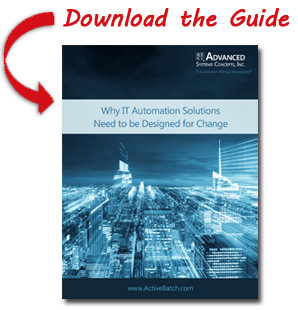4 Top Trends in IT Automation for 2016
From SaaS-based offerings and IoT to API connectivity and security-driven workflows, see what our top Workload Automation (WLA) trends are for 2016.

As we start looking toward 2016, we see a lot of new and exciting changes on the horizon for workload automation. While automation has always been considered a core foundational piece for IT to manage the IT environments, we’re starting to see a shift as automation is becoming a core driver of innovation and agility for the business. So let’s take a look at what’s to come for workload automation in 2016:

True End-to-End Connectivity with API Accessibility
Even though APIs have been around for over a decade, today they are emerging as the preferred connection method for cloud, mobile devices, and really just about any end-point you can name. According to a survey of IT professionals by research firm EMA, 95% of respondents reporting provider APIs are “critical” or “very important” to the business and 90% of respondents reporting consumer APIs are “business critical” or “very important”.
Moreover, as REST becomes the dominant model for Web Services, with REST now representing over 70% of public APIs today, automation solutions must look toward providing support for REST as part of their API strategy. While most automation solutions today offer some API capabilities such as support for WSDLs and .Net Assemblies, most solutions only provide very basic capabilities without really giving users the true benefits of API connectivity. In 2016, we think automation solutions will improve support for APIs by providing true end-to-end connectivity and reusability between APIs and applications, without the need for custom scripting.

Security-Driven Automation
In today’s world where security hacks and cyber-attacks are commonplace, organizations must protect their network and data as a price of doing business. As a result, IT is identifying both preventative measures to fend off potential security breaches as well as reactive measures to help trace the source and remedy the situation more efficiently.
According to research by Gartner, 70% of businesses have had to go into disaster recovery due to security breaches in the past two years alone. Today, security breaches aren’t a possibility, they are a certainty.
Automation will need to address security concerns by helping to minimize the risk of security breaches and shorten the downtime that occurs as a result of a breach. Workload automation solutions will have to add new levels of security to ensure automated user credential management and a secure workflow environment where access to objects is based on permissions and there is a visible, reportable audit trail for organizations to trace what changes are made and by whom.

Unlocking the Potential of Automation for IoT
Similar to API connectivity, the Internet of Things isn’t really all that new. The IoT has been around in some form since organizations began connecting devices over networks decades ago. For example, Cable TV companies have long communicated with set-top boxes in their customers’ households. However, the IoT is growing rapidly. According to Gartner, there were 4.9 billion connected things in use in 2015, up 30 percent from 2014, and the number of connected things is expected to reach 25 billion by 2020. In business environments, where each employee has a number of connected devices, there needs to be some orchestration to manage these devices and tools.
Over the years, and especially in 2016 as businesses begin to make headway into IoT practices, IT will need to more heavily utilize and leverage automation to collect and transfer data from various devices and sources. Rules-based and policy driven IT automation will interpret the processes, understand and recognize the dependencies, and perform the critical monitoring that allows for the connections between people, between devices, and between people and their devices, to exist.

SaaS-Based Offerings or Pay-As-You-Go to Emerge
While SAAS-based are popular in many enterprise IT areas now, the workload automation market has been resistant to SAAS-based offerings. Today, most automation solutions support dynamic workload placement and monitoring in hybrid cloud environments that utilize both on-premises and cloud systems like EC2, Azure, and more as needed. With automation solutions being able to manage workloads across hybrid cloud environments, SaaS based offerings are starting to make more sense for many organizations.
SAAS offers a variety of different benefits such as lower initial costs as there are is no heavy upfront investment. This also means lower costs for hardware, software, and the people needed to manage the software. Additionally, upgrades are simpler because the SaaS provider manages all updates and upgrades without requiring the customer to download or install anything.
In order to meet this need and help deliver the benefits of SaaS, we think a major trend for key workload automation vendors will be providing a SaaS-based or Pay As You Go offering for customers in the next few years.
2016 promises to be an exciting time for the workload automation industry. I personally look forward to seeing what we can accomplish here at Advanced Systems Concepts and hearing from automation users on what they see as their biggest challenges and goals for automation in the future.
Lean more about the key benefits of a modern automation solution by downloading our latest White Paper:








